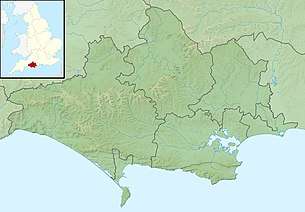River Allen, Dorset
The River Allen is a river in the county of Dorset in South West England. It flows for 14 miles (23 km) and has its confluence with the River Stour in Wimborne Minster.[1][2]
| River Allen | |
|---|---|
 The river close to Furzehill | |
 Location within Dorset | |
| Location | |
| Country | England |
| County | Dorset |
| , South West England | |
| Physical characteristics | |
| Source | |
| ⁃ location | Monkton Up Wimborne, Dorset |
| ⁃ coordinates | 50°55′15.1″N 1°58′52.6″W |
| Mouth | |
⁃ location | Wimborne Minster, Dorset |
⁃ coordinates | 50°47′33.4″N 1°58′43.3″W |
| Length | 14 mi (23 km) |
| Basin size | 40 sq mi (100 km2) |
| Basin features | |
| Tributaries | |
| ⁃ right | Crichel Stream |
The River Allen starts at Wyke Farm as a winterbourne and flows down to Monkton Up Wimborne and then tracks its way to the Watercress farm, follows down to Honeybrook Farm, to a mill and then to Canford Bridge in Wimborne Minster that is the mouth of the river. The river is known as a classic chalkstream which supports a good fishery for trout and used to support a good salmonid population.[3] A large amount of the river banks are privately owned by two estates including the Shaftsebury Estate at the source.[4]
Since 1946, the water from the Allen has been abstracted for domestic and industrial use. The amount of water taken was having a detrimental effect on the river flow whilst at the same time the salmonid population dropped significantly. Studies have been undertaken as a correlation between the two events and have resulted in the abstraction rate being reduced by 50%.[5] Over the last twenty years there has been an increase in arable farming (wheat, barley, oats oilseed rape and peas[6]) as well as some water cress farming discharge reaching the river.[7] The Allen is involved in a major restoration project led by Dorset Wildlife Trust with funding from Wessex Water and Dorset Area of Outstanding Natural Beauty.[8]
The Allen had the strongest population of white clawed crayfish in Dorset and measures such as tree planting and slowing the flow of the river down were implemented to help the species.[9] However, an outbreak of Crayfish Plague was discovered on the river in 2014 with at least 100 of the native species found dead in the river.[10] The river also contains an abundance of macrophytes including the two most abundant taxa; Common water-crowfoot (Ranunculus) and Bur-reeds (Sparganium).[11] As well as an abundance of brown trout the river also homes the critically endangered European eel, minnow, dace, grayling, salmon, perch, roach, pike, bullhead and brook lamprey.[12]

References
- "Allen(Headwaters)". data.gov.uk. Environment Agency. Retrieved 19 November 2016.
- "Allen (Lower)". data.gov.uk. Environment Agency. Retrieved 19 November 2016.
- Thomas, Andy (July 2008). "River Allen, Dorset" (PDF). wildtroutttrust. Wild Trout Trust. p. 2. Retrieved 19 November 2016.
- "Shaftesbury Estates". shaftesburyestates.com. Retrieved 10 May 2020.
- Rodda, John C; Robinson, Mark (2015). "9. Ecohyrdology". Progress in Modern Hydrology. Chichester: Wiley Blackwell. p. 269. ISBN 978-1-119-07427-4.
- http://www.shaftesburyestates.com/st-giles-farms/
- https://assets.publishing.service.gov.uk/government/uploads/system/uploads/attachment_data/file/291733/scho1109brhm-e-e.pdf
- https://www.dorsetwildlifetrust.org.uk/what-we-do/protect-wildlife-and-wild-places
- "River Allen restored for rare crayfish and water voles". BBC News. 2 January 2013. Retrieved 19 November 2016.
- "River Allen crayfish plague outbreak appeal". BBC News. 27 September 2014. Retrieved 19 November 2016.
- https://assets.publishing.service.gov.uk/government/uploads/system/uploads/attachment_data/file/291733/scho1109brhm-e-e.pdf
- https://www.wildtrout.org/news/river-allen-video